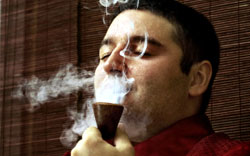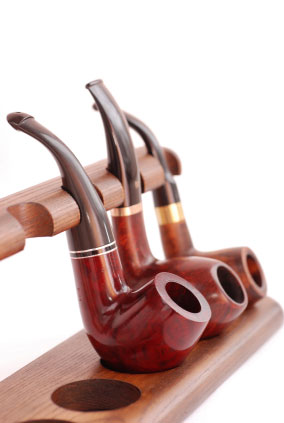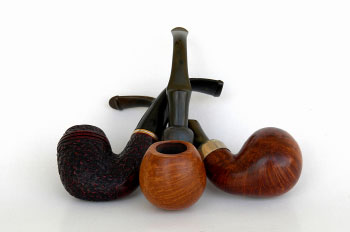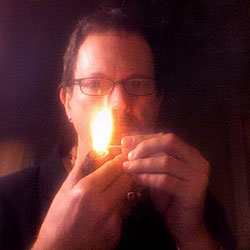By G. L. Pease
 What makes a truly great, memorable smoke? I don’t mean the every day good smoke that we become accustomed to, but those stand-out smokes where everything comes together, and we find ourselves transported to the smoky experience of Pipe Nirvana. For nearly all the years I’ve been puffing away on these wonderful little bits of briar, I’ve wrestled with the question, trying to sort out a set of reliable predictors, some meaningful rationale behind what makes a particular pipe sing with a particular tobacco. I’m sure it’s happened to all of us, and if it hasn’t, it will. We light up a tobacco we know well in a pipe that’s familiar to us, but unacquainted with that tobacco, and something magical happens. Bells ring. Chemistry is in the air.
What makes a truly great, memorable smoke? I don’t mean the every day good smoke that we become accustomed to, but those stand-out smokes where everything comes together, and we find ourselves transported to the smoky experience of Pipe Nirvana. For nearly all the years I’ve been puffing away on these wonderful little bits of briar, I’ve wrestled with the question, trying to sort out a set of reliable predictors, some meaningful rationale behind what makes a particular pipe sing with a particular tobacco. I’m sure it’s happened to all of us, and if it hasn’t, it will. We light up a tobacco we know well in a pipe that’s familiar to us, but unacquainted with that tobacco, and something magical happens. Bells ring. Chemistry is in the air.
It’s that special moment when briar, leaf, mood all align in harmony with the full moon, and we have one of those memorable smokes that we wish would never end. But, the moon has a dark side, too, in whose shadow the opposite happens. We put a tobacco we enjoy, in a pipe that has always delivered the goods, and for some inexplicable reason, end up with a stinker of a smoke.
I had one of those special moments the other night. There’s this charming old Wilke author (shown below) that I’ve described as having some kind of briar bipolar disorder. It is without question the most finicky pipe I’ve ever owned. Under most circumstances, I’d have just gotten rid of the thing after the first few bad experiences, but there’s something about this pipe that compelled me to be forgiving of its quirky nature, and keep trying. Prior to that night, I had had some good smokes in it, and some terrible ones, but never a great one. Subconsciously, though, I seemed to know there was something special there that would, one day, be revealed.
It turns out this pipe’s performance is not only style specific, but blend specific. It despises virginias of any sort, and, when filled with them, viciously delivers an acrid smoke that burns my tongue like the business end of a branding iron, offering nothing at all pleasant in the process. Rich, dark, Latakia laden mixtures are a different story. The first bowl of Abingdon I smoked in it was redeeming; the smoke was very good. After a rest, I went to another full Latakia mixture that I often enjoy and know well, with dreadful results. Huh? Back to Abingdon, and again, excellent. I’ve smoked a dozen or so different mixtures in the pipe since. It likes a few, is indifferent to most, and really despises a couple others. So, I’d found a blend that works with this pipe, but, what about that special moment?
 I’d been working on a new blend, and I decided to give it a go in the Wilke, to see how Mr. Finicky would like the new composition. The prototype blend had been a regular companion for a couple weeks, so I was quite familiar with it, and figured I knew what to expect. A quick fill. Grab a box of matches. Strike and light.
I’d been working on a new blend, and I decided to give it a go in the Wilke, to see how Mr. Finicky would like the new composition. The prototype blend had been a regular companion for a couple weeks, so I was quite familiar with it, and figured I knew what to expect. A quick fill. Grab a box of matches. Strike and light.
An absolutely brilliant smoke! And, subsequent smokes with the same blend have yielded similarly wonderful experiences. For me, for my packing and smoking style, for my peculiarities of preference, this high-strung little gem has become a one-tobacco pipe, at least for the time being. I can live with that, even if I cannot explain it. I would bet, though, that another smoker might have a completely different experience with it. This pipe certainly represents some sort of extreme. It’s the only one I’ve ever had that is so particular, and I think I’m glad about that, though when it’s giving me one of those exquisite smokes, I’m not so sure. It’s a Formula 1 car, a thoroughbred. It’s finicky, but I found something that works. I can live with that.
Many things influence our smoking experience. There are the obvious ones – the tobacco, the briar, the construction of the pipe, the way we’ve packed it, how we light the pipe, the depth and cadence of our puffing, the thickness of the cake. Other influences are less apparent, like what we’ve eaten, the vitamins we’re taking (a deficiency of zinc, for instance, has been implicated in some studies to interfere with taste sensitivity), the weather, even our mood and our expectations. It may be impossible to create an exhaustive list, and there’s probably little benefit in trying. Pipe smoking, from an analytical perspective, is a far more complex system than it may appear to be, involving a great many non-linear variables, some known, some unknown. We can try to apply science to the questions, but, unless we’re willing to naively accept reductionistic explication as a pipe smoker’s Universal Truth, all we can really hope for is a rudimentary understanding of small pieces of a big puzzle.
 Behind the veil of our incomplete understanding, though, we can count on the more relativistic notion that there are combinations of pipe and tobacco, set and setting, that make special moments, and shouldn’t that be enough? Maybe so. Visiting the world of science behind our pastime may satisfy intellectual curiosity to some degree, but it probably does nothing to qualitatively enhance the enjoyment of our smokes. (I’ve often been accused of "over-thinking" things like this. So it goes.)
Behind the veil of our incomplete understanding, though, we can count on the more relativistic notion that there are combinations of pipe and tobacco, set and setting, that make special moments, and shouldn’t that be enough? Maybe so. Visiting the world of science behind our pastime may satisfy intellectual curiosity to some degree, but it probably does nothing to qualitatively enhance the enjoyment of our smokes. (I’ve often been accused of "over-thinking" things like this. So it goes.)
I have always put the wood far above the so-called "engineering" of a pipe when thinking about what might make it a good or bad smoker. Mis-drilled pipes can usually be corrected. Bad briar cannot. A poorly drilled pipe might gurgle, or be difficult to keep lit, or refuse to burn to the bottom, but bad wood simply tastes horrible. I’d rather use a box of matches and have a delicious smoke than have the pipe smoke itself and emit noxious combustion byproducts. Of course, the best of all worlds is great wood and great construction, and it’s a joy when that happens. We get caught up in the construction details because it’s the only thing that we can actually evaluate quantitatively. A few minutes examination, and you can tell whether a pipe is properly made. When examining a pipe, we take what we can get. The briar, on the other hand, doesn’t offer visible or measurable clues about how it will taste, and the variation of flavor can be dramatic.
The other night, I smoked the same tobacco in two very similar pipes – pipes from different makers, but with the same relative dimensions and internal construction, and had two very different smokes. Both were thoroughly enjoyable, but one was bright, sweet, almost citrusy, the other deep, dark, earthy and rich. It was like smoking two different blends. Both pipes are well broken in, and I’ve smoked the same type of blend in each from the beginning, so I’m reluctant to blame it on the haunting of previous ghosts. I’m left to believe that the briar continues to influence the taste of the tobacco even after many bowls. (For the record, I do keep the cake in my pipes trimmed to a very thin layer.)
On the dark side, I’m sure we’ve all had the experience of a terrible smoking pipe, one that would make even the best tobacco sting like a mouthful of angry hornets. I tried for over a year to "reform" one such pipe of its evil ways, even resorting to chemical treatments, and a variety of bowl coatings, only to finally give up and acknowledge that it was a pipe without any possibility of redemption. I finally gave it to a friend, telling him about the pipe’s year-long history with me. He now believes me insane; it smokes just fine for him.
 Some pipes can be smoked all day, while others get grouchy if they don’t get a good rest between smokes. One pipe likes one kind of tobacco, another deliver the goods with another style, while a third might taste great even filled with dried lawn clippings. There’s no end to the stories, and the only thread that reliably and consistently ties them together is that pipes are mysterious things. There’s certainly science behind this, but none of us are smart enough, at least given our current level of understanding, to convincingly map out very much of the territory. Arthur C. Clarke wrote, "Any sufficiently advanced technology is indistinguishable from magic." Though pipe smoking certainly isn’t advanced technology, the physics behind it are sufficiently complex that it might as well be. Relativism seems our only recourse. Either that, or simplistic reductionism. I’d choose the vagaries of the former over a fundamentalist’s adherence to the latter any day. Personally, I enjoy the mysteries. They add another dimension to the pleasure of the pastime. Every pipe is an individual, and getting to know them is part of the journey. Make friends with your pipes, and they’ll reward you in kind.
Some pipes can be smoked all day, while others get grouchy if they don’t get a good rest between smokes. One pipe likes one kind of tobacco, another deliver the goods with another style, while a third might taste great even filled with dried lawn clippings. There’s no end to the stories, and the only thread that reliably and consistently ties them together is that pipes are mysterious things. There’s certainly science behind this, but none of us are smart enough, at least given our current level of understanding, to convincingly map out very much of the territory. Arthur C. Clarke wrote, "Any sufficiently advanced technology is indistinguishable from magic." Though pipe smoking certainly isn’t advanced technology, the physics behind it are sufficiently complex that it might as well be. Relativism seems our only recourse. Either that, or simplistic reductionism. I’d choose the vagaries of the former over a fundamentalist’s adherence to the latter any day. Personally, I enjoy the mysteries. They add another dimension to the pleasure of the pastime. Every pipe is an individual, and getting to know them is part of the journey. Make friends with your pipes, and they’ll reward you in kind.
Your turn.
-glp

Since 1999, Gregory L. Pease has been the principal alchemist behind the blends of G.L. Pease Artisanal Tobaccos. He’s been a passionate pipeman since his university days, having cut his pipe teeth at the now extinct Drucquer & Sons Tobacconist in Berkeley, California. Greg is also author of The Briar & Leaf Chronicles, a photographer, recovering computer scientist, sometimes chef, and creator of The Epicure’s Asylum. |
















Yet another fine read Greg.
I think you have registered a bulls-eye on a constantly moving target.
While; “Any sufficiently advanced technology is indistinguishable from magic.” may be true, I think if one is in conscious pursuit of, or intends to smoke that “magic” bowl of tobacco he or she is setting themselves up for disappointment.
If, on the other hand, one set’s out to enjoy a bowl of his favorite blend – stuffed into that old and familiar friend made of briar, apple, cherry or meer – in one of those comfortable and familiar, or special and unique surroundings/atmospheres… then that “magic” can and will often become manifest. You just have to let it happen.
Thanks again Greg for a most enjoyable read.
Thanks for a very nicely written article. I’m very much of the opinion that pipes and blends find each other; and those truly wonderful smokes are, well, kismet. The Elysian delight is never precisely and predictably reproduceable, but as Lawrence suggests above, one can put the odds in his favor. Over time I’ve come to view each bowl and blend combination as a unique adventure being added to that pipe’s “anthology” from which I draw, excuse the pun, as memory serves and mood dictates.
Mr. Pease has again given voice to our eternal pursuits; a fine read.
Thank you , gentlemen.
Thank you for a wonderful article. It reminds me that as much as we are smokers, we are also hobbyists. We try to work on our habits knowledge and tools as actively as any other group. We utilize pipes to take us on a escape.
Another great article Mr Pease. I think Lawrence hit the nail on the head. Not only the pipe and tobacco, but also the environment you may find yourself in at that particular moment of smoking bliss. I had a moment like that in the smoking tent at the Chicago Pipe Show. Being around friends new and old, enjoying the same hobby. Thats the kind of memorable smoke you don’t forget. At least for me.
Thank you, sir. A wonderful article. As a ‘returning’ pipe smoker after many years, I have the pleasure of re-discovering the wonderful world of pipes and tobaccos. Looking forward to many more, including yours! Thank you again for such great expression and passion for the pipe.
Great Article Greg – I am still after all these years trying to figure out why some pipes smoke well and others smoke like dog poop. My biggest frustration has been – some pipes can take repeated smokes (if done in a certain period of time with short breaks between refills) – while others – if I let the pipe sit for a couple of hours or more offer an acrid disgusting smoke that is an insult to the tobacco that is in it. Not to mention often giving me a trashed palate. I clean my pipes religiously with Bj Long Tapers and Everclear and let them rest for a week. So I don’t think it is a cleanliness issue. Any thoughts?
Just when I was about to ask your opinion on what makes a particular tobacco meld so well with a particular pipe, you up and tell me that you don’t know either. Bother!
Most of what you said, Greg, made sense to and resonated well with me except for the final conclusion. I am not sure I’d agree with the notion of having to work too hard on making myself to like a pipe or tobacco, if they fail to impress me after either having their proverbial chance to do so or after my usual amount of effort spent on breaking in a new pipe did not bring any likeable results. A good example: I did not like your “Union Square” the first time I tried it at all. After a couple of weeks, in a different pipe and in a different setting, it opened up and sang. Great! However; another good quality and ingredient tobacco, that should remain nameless, did not work for me in four different pipes, no matter the environment. I will not give it any more of my time, it’s just not worth the effort. Same with pipes. A friend of mine keeps saying that with a proper amount of effort, just about any pipe can be broken in to the point when it gives consistently good taste. I don’t particularly subscribe to that opinion. There are just too many good pipes and tobaccos and too little time for us to try enjoy them all, in general. Why bother and walk an extra mile?
Best regards,
Naum
Naum, I don’t think we’re in disagreement, here. There are pipes and tobaccos that just do not work for one person, for whatever reason. My mention of a stinker that I spent so much time with is a pretty extreme case, even for me. The pipe was just so beautiful to look at that I really wanted it to be a great smoker. I’ve found, more generally, that if it doesn’t taste pretty good after a few bowls, it’s not the pipe for me. That doesn’t mean that I’ll find that special combination of pipe and tobacco so quickly, and on rare occasions, a pipe that is truly awful with one blend style has proven itself magnificent with another. Usually, though, it’s not quite so dramatic as that. For me, Latakia mixtures tend to be more pipe sensitive than virginias, but I’ve known plenty of pipesters who feel the opposite true. There are too many variables to quantify any of this, I think. But, I maintain that, assuming the pipe is a good one, and that we’re smoking good tobaccos that suit our preferences, “making friends” with the pipe is the surest course for more of those great smokes. It doesn’t seem to me that making friends should be construed as hard work!
Clanobucklin – that’s one of the great mysteries—why one pipe can tolerate seemingly infinite abuse, whilst another snarls and bites at the slightest provocation. I’m sure it has something to do with the briar. How’s that for a nebulous “answer?” Seriously, I’ve never found a satisfactory explanation for this. I’ve got pipes that I can smoke several times in a row with wonderful results, and pipes that are fantastic for the first bowl, but increasingly acrid and harsh unless left to rest. Some might dismiss these as poor smokers; I just consider it a personality quirk that adds to their unique charm.
“…For me, Latakia mixtures tend to be more pipe sensitive than virginias, but I’ve known plenty of pipesters who feel the opposite true…”
I am in that “opposite” camp on this one. I just cannot enjoy Virginia tobacco in a bowl that was smoked with either Latakia or Orientals, because of how overpowering the ghost smell/taste will affect the smoke for me. When looking to purchase an estate pipe, I always ask the seller if they can smell Latakia in the pipe and if the answer is “yes”, I just don’t buy it. Unfortunately, the information sometimes turns out wrong and I have to either dedicate the pipe for Latakia/Orientals, which I almost stopped smoking these days in favour of Virginia flakes, or just re-sell the pipe.
Mr. Pease – Just tried my first bowl of your ‘Triple Play’ – thank you and well done! It is Grand-Slam, Kick-Ass good!
“Mr. Pease – Just tried my first bowl of your ‘Triple Play’ – thank you and well done! It is Grand-Slam, Kick-Ass good!”
Thanks! I’ll take kick-ass good as a very serious compliment. 😉
“I’ve got pipes that I can smoke several times in a row with wonderful results, and pipes that are fantastic for the first bowl, but increasingly acrid and harsh unless left to rest. Some might dismiss these as poor smokers; I just consider it a personality quirk that adds to their unique charm.”
I sometimes think it’s down to briar density (rather than quality) Greg.
There are pipes that smoke superbly but seem to absorb a lot of tars and gunk and cleaning after smoking gives a filty cleaner – these pipes don’t respond to re-smoking without a significant rest period. Others, whilst smoking equally as well, seem to absorb nothing and a subsequent cleaner comes out virtually white – these seem to be re-smokeable a few times without resting.
Good points, Jim, and I think you may be onto something regarding the density of the wood. When I look at old Barlings, I’m always intrigued by their swirly, broadly spaced birdseyes, not at all consistent with our modern love affair with tight, even straight grain, yet those old Barlings can smoke brilliantly, though I can’t say whether or not they’ll support more frequent smoking. I’ll have to pay closer attention to which pipes I can smoke often, and which ones must be more fully rested between bowls. (My normal tendency is to rotate pipes, so I rarely smoke the same briar more than once without a good rest.)
Ohh heavens, the pipes that I have…some so terribly contrary that they’ve been placed in the wastebasket only to be removed once I’ve settled down. The finicky nature of these devices I once accepted as part of the hobby–as part of the learning curve of pipery. But then, at my tobacconist’s shop I picked out a very dusty, ignored through the ages, a brier poker made by Cassano. Its heavy, ugly, may as well have been composed from two logs slammed together perpendicularly by a ham-fisted neanderthal with a lucite bit scabbed on as an afterthought. It smokes everything. It smokes when I’m not smoking. I will tell you people, that this pipe loves me!!! Often, we talk about treating the pipe with respect and admiration while we applaud its shape, dimensions, smoking qualities, and origins. More often than not, we seek the pipe’s favor, and alter ourselves accordingly. But my poker, ladies and gentlemen, seeks mine.
I have also found, that if you toss a finicky pipe into the rubbish bin for an hour or two, then liberate them, they become a bit more cooperative. Pipes have enormous egos, from time to time, they need to be reminded that there existence is based on the benevolence of their master. In effect, several of my pipes have expressed concern over my favor towards the ugly poker. They say things like. “but I’m a Peterson, ergo, I’m better!” Or, “I’m and estate from Sweden, I was sculpted by artists!!” I assure you–to all that might read this, that a day in the rubbish bin will squelch these premadona proclivities that some of your pipes may have. Pipes are jealous and vain–well, some of them are. I bet you know which ones when you look at your collection. Toss one or two in the bin–and let the other pipes watch as you do it. I guarantee great smokes for at least three weeks.
AJWINTER, that is awsome. But I found quicker results with a rolled-up newspaper. Lord we are a twisted bunch.
I totally understand what you mean by the Pipe Nirvana. I’ve had it a couple of times. Once with Sweet Killarney. I decided one night to pair it up with a glass of Bailey’s and something clicked with the two that night that I haven’t been able to replicate with that blend. Maybe the weather was the right temperature and the breeze was just slow enough to continually enjoy the smoke and maybe it had something to do with the pipe shape I loaded up that evening. I’ve also experienced it with Connoisseur’s Choice when I paired it up with a glass of Jim Beam’s Red Stag. It was a fairly cool night with a very light breeze and the atmosphere, the drink, and the blend married together more wonderfully than ever. I love those nirvanas, but I don’t ever go into smoking hoping for one. I merely embrace the time spent in it while it happens. It’s amazing how different each smoke is regardless of pipe shape or tobacco blend. That’s why I love pipe smoking. It’s a new adventure every time.
Don’t overlook the involvement of the Spirit in all this, AKA Cherokee Tribe views on tobacco. It is interesting to note the connection of breath awareness, quiet and traditional meditation practice; those items go together like ham and eggs; something like Coltraine’s employment of breathing techniques while playing sax (and he was a good friend of Ravi Shankar since 1959).
That’s my best take on the subject thus far.
I find the same thing, roughly, can happen with musical instruments.
For years, my mainstay/bring the money home bass was a Conklin Groove Tools 7, which has the basic proportions of an aircraft carrier. The thing took me a solid year to get my left hand in the right shape to play it without pain, but, once it and I came together, it could play anything. It doesn’t have a signature sound, but that sound fits any genre (tobaccos), and it always delivers.
On the other hand, let’s talk about my Lākland 55-94, nicknamed ‘the Princess’. It’s a wonderful, high end, professional quality instrument–and has always been somewhat of a pain-in-the-ass. Lean into her, and she rebels. Whisper at her, and she sometimes ignores you. She never, ever has told me what she likes, but has been more than eager to point out my shortcomings.
How did I tame her? By throwing on flatwound strings (think ‘stingers’ in a pipe), setting the action way higher than she likes, and spanking that spoiled brat until she submitted. I’ve inadvertently nicked her, chipped her, and had her fall against a brick wall. She’s taken my apologies for the rough treatment, and sings like a low frequency bird. She prefers jazz and folk, but she rocks at rock, hews the blues and can sound like an upright.
I also have put her on ‘time out’ in the closet, which has done wonders for her attitude.
I’ve played on basses that are the roughest looking rednecks you could possibly want to avoid, and they’ve been champs, if only for a few genres.
This rambling is pointing in one direction–different bits of wood take different approaches, but can shine with the right treatment…or the right ‘wrong’ treatment.
Amazin’ how that works.
Great read as usual Greg. This begs the question does pipe smoking or can pipe smoking lead to a meditative state. I provide the following link for a lively discussion on this very topic: http://www.smokersforums.co.uk/showthread.php?t=96459.
Gregory thank you for your fine introspect all i can say is the most important thing is when you have fine tobacco that you love and your favoriate pipe the moment of truth comes when eveything else around you is as one at that moment only then everything is right with the world-FC.